As such, our major goal on this manuscript is to look at the intricate relations between workplace anger and work outcomes, taking into consideration the potential position of coping methods and particular person variations. To attain this goal, we’ve devised a conceptual mannequin primarily based on affective occasions concept (Weiss and Cropanzano, 1996) and enhancements from cognitivist accounts of emotion (Lazarus, 1991; Frijda, 1987; Moors et al., 2013). Our conceptual mannequin assumes that workplace anger may be disadvantageously related to work outcomes, but additionally considers the chance that this relation could also be advantageous underneath sure circumstances. These circumstances embrace the coping methods employed to deal with workplace anger and the person variations that will exist amongst staff. To check our conceptual mannequin, we are going to collect knowledge from a pattern of full-time staff throughout numerous industries over a two-week interval. Knowledge can be collected every workday utilizing a time-lagged experience-sampling methodology.
Furthermore, we intention to make a theoretical contribution by inspecting the differing assumptions concerning the relation between workplace anger and purpose attainment in affective occasions concept (Weiss and Cropanzano, 1996) and cognitivist accounts of feelings (Lazarus, 1991; Frijda, 1987; Moors et al., 2013). We advise that the discrepancy in these assumptions might stem from the shortage of emphasis on coping methods in affective occasions concept in comparison with cognitivist accounts of feelings, which prioritize coping methods. Our speculation is that coping methods related to workplace anger can considerably affect the relation between workplace anger and purpose attainment. By incorporating coping methods similar to ruminative coping (extreme inner pondering about an anger-inducing state of affairs; Li et al., 2019) and confrontative coping (overtly and antagonistically addressing an anger-inducing state of affairs; Folkman et al., 1986) into our conceptual mannequin, we intention to discover how these methods might influence the relation between workplace anger and purpose attainment.
Lastly, our research goals to look at the influence of particular person variations on the relation between workplace anger and work outcomes. Earlier analysis has ignored employee-level components inside the context of affective occasions concept. To handle this hole, we embrace the core human disposition of workplace affiliation in our conceptual mannequin (Ryan and Vansteenkiste, 2023). This disposition is in keeping with the interaction-oriented theoretical frameworks of affective occasions concept and cognitivist accounts, suggesting that it could affect the interconnectedness of workplace anger, coping methods, and work outcomes. By investigating employee-level components by way of the lens of affective occasions concept, we try to realize a greater understanding of the significance of particular person variations inside this theoretical framework.
Theoretical background and hypotheses improvement
Affective occasions concept
Affective occasions concept is an affect-centered concept from the organizational sciences that focuses on the relation between feelings arising from workplace conditions and the work outcomes which can be anticipated to consequence from these feelings (Weiss and Cropanzano, 1996). Based on the idea, feelings and work outcomes usually have related valences. Optimistic feelings are more likely to result in constructive work outcomes, whereas detrimental feelings are more likely to result in detrimental work outcomes. The concept additionally means that employee-level components, similar to tendencies, are essential in understanding this relation. Nevertheless, the particular influence of dispositional components on the relation between feelings and work outcomes has not been extensively researched and stays a theoretical assumption right now. It’s value noting that affective occasions concept doesn’t expressively deal with the position of coping mechanisms inside its theoretical framework.
Cognitivist accounts of feelings and intertheoretical discourse
Cognitivist accounts of feelings problem the notion of affective occasions concept that feelings and work outcomes at all times align by way of valence. Cognitivist accounts suggest that an worker’s coping methods mediate the valence of an emotion onto the valence of a workplace final result. Two primary coping methods usually out there to staff in such conditions are emotion-focused coping and problem-focused coping.
Cognitivist accounts of emotion align with affective occasions concept in recognizing the importance of particular person variations, similar to tendencies, within the hyperlink between feelings and work outcomes. Nevertheless, there’s a distinction in perspective between the 2 theories. Whereas affective occasions concept means that tendencies straight influence the relation between feelings and work outcomes, cognitivist accounts suggest that tendencies influence this relation not directly.
Based on cognitivist accounts of emotion, tendencies have an effect on the mediation path between feelings and coping methods of staff, in addition to the mediation path between coping methods and work outcomes. In distinction, affective occasions concept means that particular person variations influence the direct relation between feelings and work outcomes (Weiss and Cropanzano, 1996). Because of this in cognitivist accounts, the connections between feelings and coping methods, in addition to coping methods and work outcomes, are moderated by tendencies. Then again, affective occasions concept maintains that solely the direct hyperlink between feelings and work outcomes is moderated by tendencies (Weiss and Cropanzano, 1996).
In abstract, affective occasions concept and cognitivist accounts of emotion supply totally different theoretical assumptions relating to the relation between feelings and work outcomes. Affective occasions concept suggests a same-valenced and direct hyperlink between feelings and work outcomes, with worker tendencies enjoying a big position in shaping this direct relation (Weiss and Cropanzano, 1996). Then again, cognitivist accounts of emotion suggest that coping methods play a mediator position in concluding the relation between feelings and work outcomes, with worker tendencies presumably additionally impacting this relation. We are going to now delve deeper into these discrepancies and their doable resolutions, following the procedural construction of our conceptual mannequin depicted in.
A case for workplace anger
The instances for workplace useful resource depletion and workplace purpose attainment
Nevertheless, this intertheoretical alignment disappears once we take into account workplace purpose attainment. This constructive work final result needs to be inversely associated to anger in keeping with affective occasions concept (Baumeister et al., 1998; Weiss and Cropanzano, 1996). In distinction, cognitivist views on emotion (Lazarus, 1991; Frijda, 1987; Moors et al., 2013) counsel that the relation between workplace anger and purpose attainment might be both detrimental or constructive, relying on the worker’s coping methods.
Given these intertheoretical alignments and discrepancies, our research will concentrate on exploring the connections between workplace anger and workplace useful resource depletion and purpose attainment, resulting from its theoretical and sensible relevance. With this focus in thoughts, we are going to now delve into the the reason why such intertheoretical discrepancies may exist and suggest our hypotheses accordingly.
The relations between workplace anger and coping methods
We’ve established that the anticipated outcomes might differ when considered by way of competing theoretical frameworks. Particularly, we argue that the variation in these outcomes may be attributed to the differing emphasis positioned on coping methods in affective occasions concept (Weiss and Cropanzano, 1996) in comparison with cognitivist theories of feelings (Frijda, 1987; Lazarus, 1991; Moors et al., 2013). Whereas cognitivist theories spotlight coping methods as essential parts, affective occasions concept tends to downplay their significance (Weiss and Cropanzano, 1996). Due to this fact, our assumption means that coping methods related to workplace anger might considerably influence the path of the relation between workplace anger and workplace useful resource depletion, in addition to purpose attainment. In essence, coping methods may decide whether or not this connection is constructive or detrimental. To additional discover this speculation, we are going to study the potential position of coping methods in shaping the hyperlink between workplace anger and workplace useful resource depletion, in addition to purpose attainment.
Based on cognitivist theories, staff can make use of both emotion-focused coping or problem-focused coping methods to deal with conditions that set off feelings within the workplace (Lazarus, 1991). Emotion-focused coping includes internally regulating feelings, whereas problem-focused coping includes taking motion to deal with the state of affairs that brought on the emotion. Emotion-focused coping methods associated to anger typically contain extreme inner rumination concerning the anger-inducing state of affairs, generally known as ruminative coping (Folkman et al., 1986; Folkman and Lazarus, 1985; Lazarus, 1991). Then again, problem-focused coping methods related to anger usually contain straight confronting the anger-inducing state of affairs, known as confrontative coping. Primarily based on this, we suggest the next two hypotheses to be examined:
Speculation 1: There’s a constructive relation between workplace anger and (a) ruminative coping in addition to (b) confrontative coping.
The relations between coping methods and work outcomes
Speculation 2: There’s a (a) constructive relation between ruminative coping and workplace useful resource depletion in addition to a (b) constructive relation between confrontative coping and workplace useful resource depletion.
In our assertion, we suggest that the relation between coping methods and workplace purpose attainment ought to observe the same sample. Due to this fact, it’s essential to discover the coping methods related to anger within the workplace. With this understanding, it’s cheap to hypothesize that ruminative coping might negatively relate to workplace purpose attainment, whereas confrontative coping might have a constructive relation.
Speculation 3: There’s a (a) detrimental relation between ruminative coping and workplace purpose attainment in addition to a (b) constructive relation between confrontative coping and workplace purpose attainment.
The oblique relations between workplace anger and work outcomes
To this point, we’ve examined the assumed direct relations between our theoretical constructs. Nevertheless, you will need to observe that each affective occasions concept and cognitive accounts of feelings counsel a procedural nature of those relations and constructs. As our primary focus on this paper is to find out if the relation between workplace anger and work outcomes is constantly constructive when taking coping methods into consideration, you will need to examine this in a extra detailed method. Due to this fact, we plan to discover the oblique results between workplace anger and work outcomes by way of the usage of coping methods. Constructing upon the hypotheses we’ve developed relating to their direct results, we suggest 4 mediation hypotheses to be examined in our analysis:
Speculation 4: There’s a (a) constructive relation between workplace anger and workplace useful resource depletion through ruminative coping in addition to a (b) constructive relation between workplace anger and workplace useful resource depletion through confrontative coping.
Speculation 5: There’s a (a) detrimental relation between workplace anger and workplace purpose attainment through ruminative coping in addition to a (b) constructive relation between workplace anger and workplace purpose attainment through confrontative coping.
A case for workplace affiliation tendencies
As we examine the core assumptions of various theoretical frameworks and their alignment with empirical proof, you will need to additionally take into account the validity of their auxiliary assumptions. One key facet to contemplate is the moderating influence of worker tendencies on the assumed relations. That is particularly essential because it illuminates one other vital theoretical discrepancy between affective occasions concept and cognitivist accounts of emotion (Lazarus, 1991; Frijda, 1987; Moors et al., 2013). Primarily, in cognitivist accounts, the relations between feelings and coping methods, and between coping methods and work outcomes, are moderated by worker tendencies. In distinction, affective occasions concept argues that solely the direct hyperlink between feelings and work outcomes is moderated by worker tendencies (Weiss and Cropanzano, 1996).
Analysis query: How does an worker’s workplace affiliation disposition influence the relations between workplace anger, coping methods, and workplace useful resource depletion in addition to purpose attainment?
Methodological congruence
With the intention to deal with the challenges of methodological incongruence within the organizational sciences (Thurston et al., 2008), our analysis goals to align our methodology carefully with the character of our theoretical constructs to attenuate any potential misfit that will come up. One key consideration on this alignment is the temporal volatility of our constructs. Constructs similar to workplace anger, workplace useful resource depletion and purpose attainment, and coping methods like ruminative and confrontative coping are more likely to fluctuate daily (Lazarus, 1991; Weiss and Cropanzano, 1996), whereas a workplace affiliation disposition tends to alter much less quickly. Moreover, contemplating our theoretical frameworks that counsel a procedural relation between workplace anger, coping methods, and workplace useful resource depletion in addition to purpose attainment (Lazarus, 1991; Weiss and Cropanzano, 1996), it is usually important to pick a methodological method that may seize this sequential nature.
We recognized a daily time-lagged experience-sampling method as an appropriate choice, as it could accommodate the differing volatilities of our constructs and the procedural relations we assume (Gabriel et al., 2019; Ohly et al., 2010; Trull and Ebner-Priemer, 2009). Whereas this method provides the benefit of elevated exterior validity (Findley et al., 2021), issues about inner validity and causality might come up. Nevertheless, given the partly exploratory nature of our analysis, we take into account that utilizing an experience-sampling method would offer essentially the most vital theoretical and sensible insights.
Methodology
Transparency and openness
The knowledge abstract and evaluation code may also be out there in the identical listing upon publication. Knowledgeable consent was acquired from each participant previous to knowledge assortment.
Choice and process
The analysis carried out on this research was ethically authorized by the committee at authors’ college. Our purpose was to acquire a various pattern of employed adults who labored a minimal of 30 h per week, with the exclusion of staff underneath 18 or over 67 years outdated. By recruiting contributors by way of scholar networks, we utilized a comparable and conventionally sturdy method to Burmeister et al. (2020) and Fasbender et al. (2021), thereby gaining all kinds of contributors from totally different networks. To seize adjustments in contributors’ experiences, we utilized an expertise sampling format over 10 consecutive workdays (Gabriel et al., 2019). As an incentive for participation, contributors obtained reward vouchers. Surveys had been despatched to contributors at three particular instances daily: 9:30 a.m. (morning survey; at work), 12:30 p.m. (midday survey; at work), and three:30 p.m. (night survey; at work). Knowledge assortment occurred between Could and December 2022. Our research’s attrition price was in line with earlier analysis (Ohly et al., 2010; Xia et al., 2021), with a 9% dropout price and a 68% compliance price for daily surveys. We noticed no vital results of gender or age on attrition charges.
Pattern traits
A complete of 1,611 observations had been collected on the employee-day experiences of 214 contributors. The common variety of observations per worker was 7.53. This pattern measurement exceeds the usual expertise sampling requirements outlined by Gabriel et al. (2019). Of the contributors, 60% had been feminine, with a mean age of 34.83 years (SD = 13.08) and a weekly work schedule of 39.26 h (SD = 4.80). Their common normal work expertise was 15.08 years (SD = 12.95), they usually had been with their group for a mean of 9.23 years (SD = 9.87). Of the contributors, 26% held management positions, whereas 74% carried out workplace duties. Moreover, 26% carried out non-office duties, and 66% labored in an workplace atmosphere. Moreover, 13% labored from dwelling, 11% at clients’, and 10% in public areas. Relating to firm measurement, 58% labored in giant firms, 16% in medium-sized corporations, 15% in small companies, and 11% in micro-companies. Lastly, 17% labored in banking, finance, and insurance coverage, 16% in manufacturing/manufacturing, 10% in public administration, 9% in healthcare, 7% in IT and communications, 6% in craft trades, 6% in training and coaching, 5% in retail/wholesale commerce, 3% in power and water provide, 2% in catering/hospitality, 2% in transportation, lower than 1% in agriculture and forestry, lower than 1% in science, and 16% in different industries.
Measures
The translation of the measurement scales from English to German was carried out utilizing the back-translation methodology described by Brislin (1970). Until in any other case said, a 5-point Likert scale was utilized, with response choices starting from 1 (indicating sturdy disagreement) to five (indicating sturdy settlement). Our number of objects was decided by contemplating issue loading matrices and theoretical congruence whereas prioritizing the minimization of participant burden by maintaining the variety of objects low (Gabriel et al., 2019). We tailored the size to the workplace and the research context by including “Immediately at work, …” to every merchandise.
Workplace anger (morning survey)
Ruminative coping (midday survey)
Ruminative coping was evaluated utilizing the 3-item scale developed by Li et al. (2019). An instance of a pattern merchandise was, “All through my workday immediately, I couldn’t cease desirous about an occasion that made me offended.” The scale exhibited a excessive stage of reliability (ω = 0.95).
Confrontative coping (midday survey)
We evaluated confrontative coping using a scale developed by Folkman et al. (1986). A pattern merchandise is, “Immediately at work, because the starting of my workday, I stood my floor and fought for what I wished” (ω = 0.76).
Workplace useful resource depletion (night survey)
We employed a set of three objects derived from Lanaj et al.’s (2014) scale to observe workplace useful resource depletion. One of many pattern questions included on this set was, “Immediately at work, since filling out the final questionnaire, my thoughts has felt unfocused” (ω = 0.87).
Workplace purpose attainment (night survey)
To ensure the precision of measuring workplace purpose attainment, we’ve built-in the 2 objects from Judge et al.’s (2005) purpose attainment scale and added one merchandise (“Immediately at work, since filling out the final questionnaire, I achieved my targets at work”), guaranteeing a minimal of three objects. The scale had an omega worth of ω = 0.91.
Workplace affiliation disposition (baseline survey)
Controls
Analytical technique and knowledge diagnostics
In our research, we carried out knowledge preparation utilizing R model 4.2.2 (R Core Team, 2022) and knowledge evaluation utilizing Mplus model 8.4 (Muthén and Muthén, 2017). The dataset consisted of a number of observations for every worker (Hayes, 2006), prompting us to make the most of 2-level multilevel modeling with random intercepts and slopes (Hamaker and Muthén, 2020). Because of the presence of non-normality, mannequin complexity, and outliers, we employed Bayesian inference in our evaluation, which has conventionally been sturdy to those points (Asparouhov and Muthén, 2021; Depaoli, 2021).
We utilized the Gibbs sampler algorithm with a 1.02 Gelman-Rubin potential scale discount issue (Gelman et al., 2013) and ran two Markov chains for 50,700 iterations. To make sure convergence, we visually inspected hint and autocorrelation plots. Our mannequin estimates had been offered utilizing the median as some extent estimate, with diffuse priors used for parameter interpretation just like conventional most probability estimation (cf. Depaoli, 2021). Lacking knowledge had been included in our mannequin estimation (Finch and Bolin, 2017).
Knowledge diagnostics revealed no abnormalities in knowledge high quality (Cullen and Frey, 1999; Delignette-Muller and Dutang, 2015; Gabriel et al., 2019). The imply proportion of lacking responses throughout variables was 23.68%, with particular charges of 16.60% for workplace anger, 25.60% for ruminative and confrontative coping, and 26.90% for workplace purpose attainment and useful resource depletion.
Outcomes
Preliminary analyses
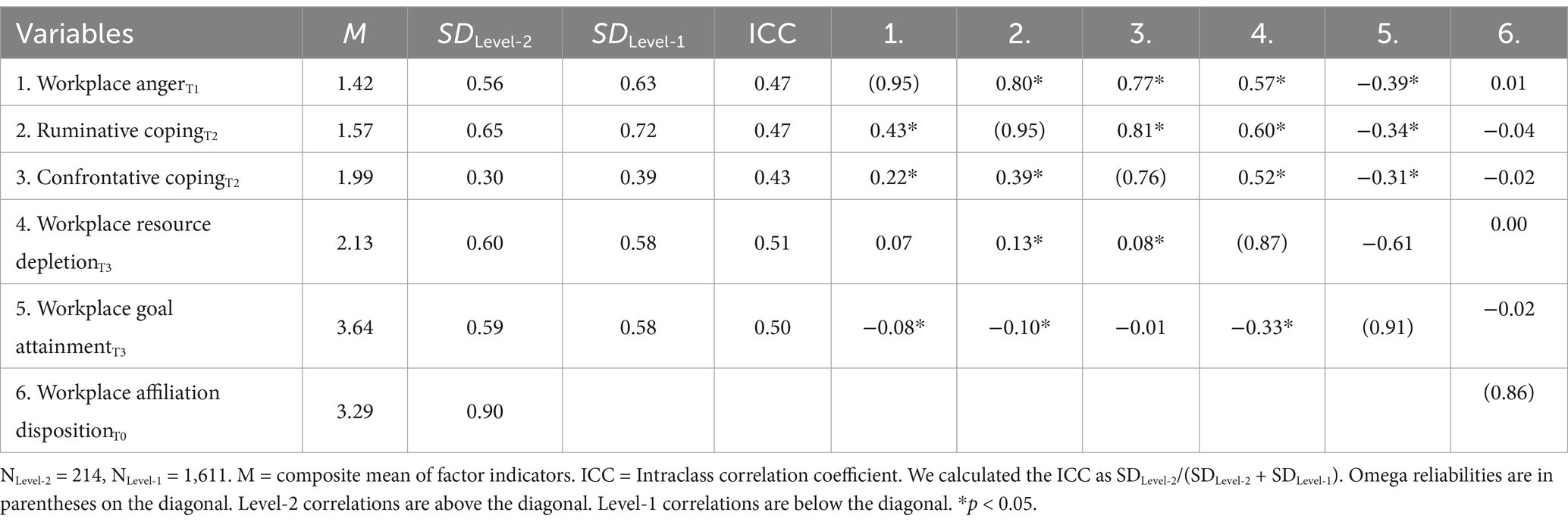

Hypotheses testing
We current the outcomes of our Bayesian structural equation modeling analyses for the direct and oblique results in Tables 3, 4, respectively. Assist was discovered for Speculation 1a, as workplace anger was positively related to ruminative coping (E(γ) = 0.392, p γ) = 0.191, p
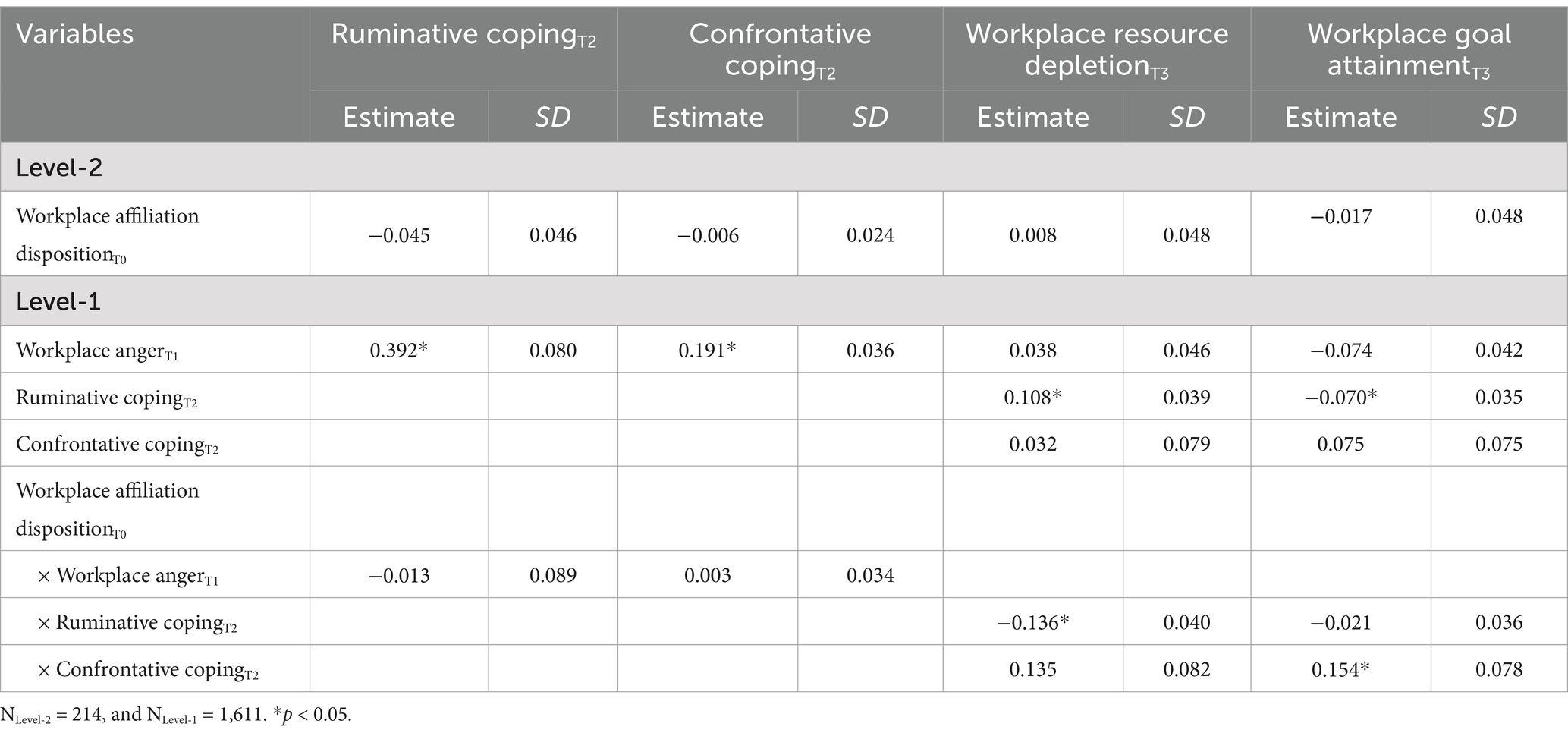

Consistent with Speculation 2a, ruminative coping was discovered to be positively associated to workplace useful resource depletion (E(γ) = 0.108, p = 0.004). Nevertheless, opposite to Speculation 2b, confrontative coping confirmed no constructive affiliation with workplace useful resource depletion (E(γ) = 0.032, p = 0.674).
Assist for Speculation 3a was discovered, indicating a detrimental relation between ruminative coping and workplace purpose attainment (E(γ) = −0.070, p = 0.046). Speculation 3b was not supported, as confrontative coping didn’t present a constructive relation with workplace purpose attainment (E(γ) = 0.075, p = 0.288).
Assist was discovered for Speculation 4a, revealing a constructive relation between workplace anger and workplace useful resource depletion through ruminative coping (E(oblique) = 0.041, p = 0.004). Speculation 4b was not supported, as workplace anger was not positively associated to workplace useful resource depletion through confrontative coping (E(oblique) = 0.006, p = 0.674).
Speculation 5a was supported, displaying a detrimental relation between workplace anger and workplace purpose attainment through ruminative coping (E(oblique) = −0.026, p = 0.046). Speculation 5b was not supported, as workplace anger was not positively associated to workplace purpose attainment through confrontative coping (E(oblique) = 0.014, p = 0.288).
Exploratory analyses
Table 4 presents the outcomes of our analyses on the conditional results. Our research discovered that the relation between ruminative coping and workplace useful resource depletion was moderated by an worker’s workplace affiliation disposition (moderation impact = −0.136, p p p = 0.590) expressions of an worker’s workplace affiliation disposition. The distinction between the slopes was vital (distinction = −0.273, p p p = 0.590) expressions of an worker’s workplace affiliation disposition. The distinction between the slopes was vital (distinction = −0.104, p Figures 2, 3, present that the relation between ruminative coping and workplace useful resource depletion in addition to the relation between workplace anger and workplace useful resource depletion through ruminative coping did grow to be non-significant with values of a workplace affiliation disposition of equal to or better than 0.240 commonplace deviations above the pattern imply, whereas turning into detrimental and vital with values of a workplace affiliation disposition of equal to or better than 2.080 commonplace deviations above the pattern imply (Table 5).
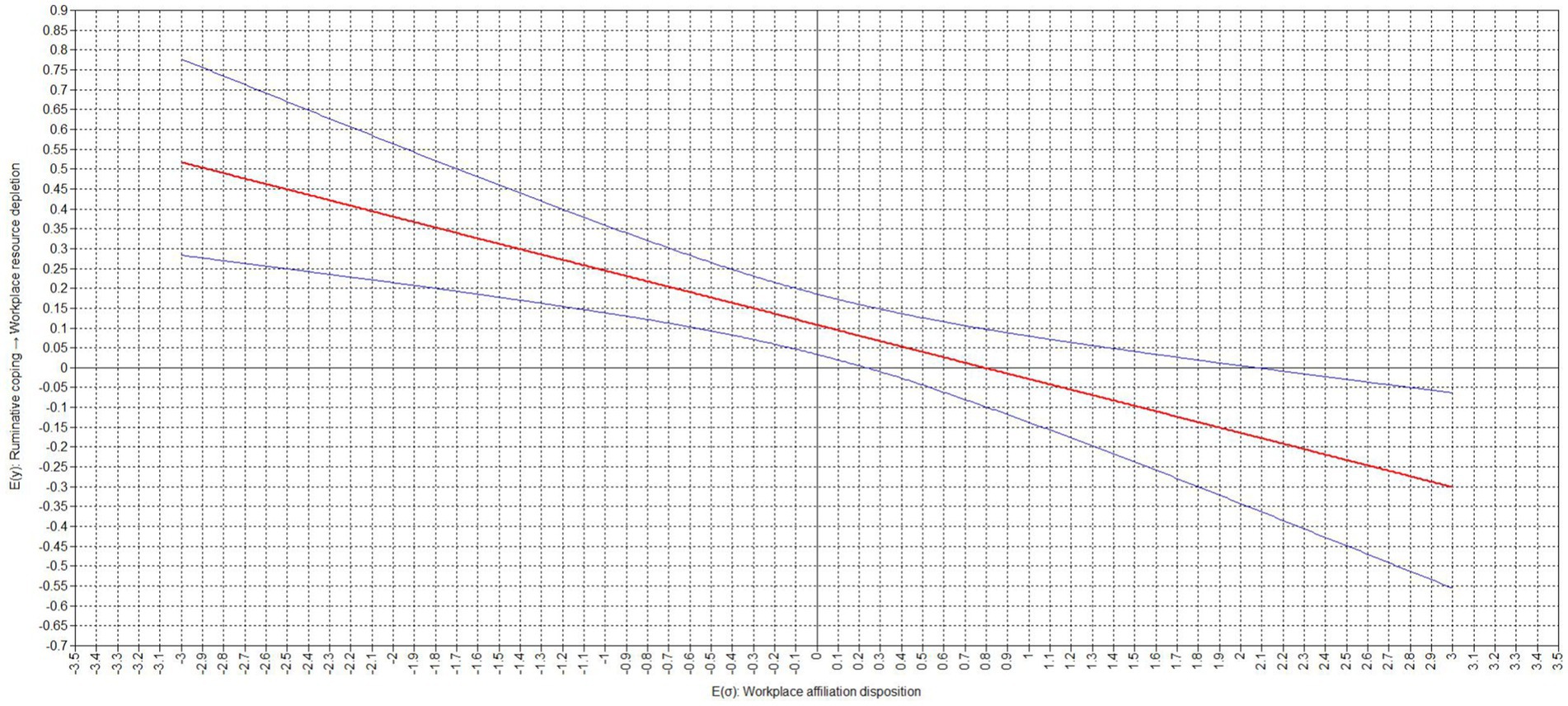
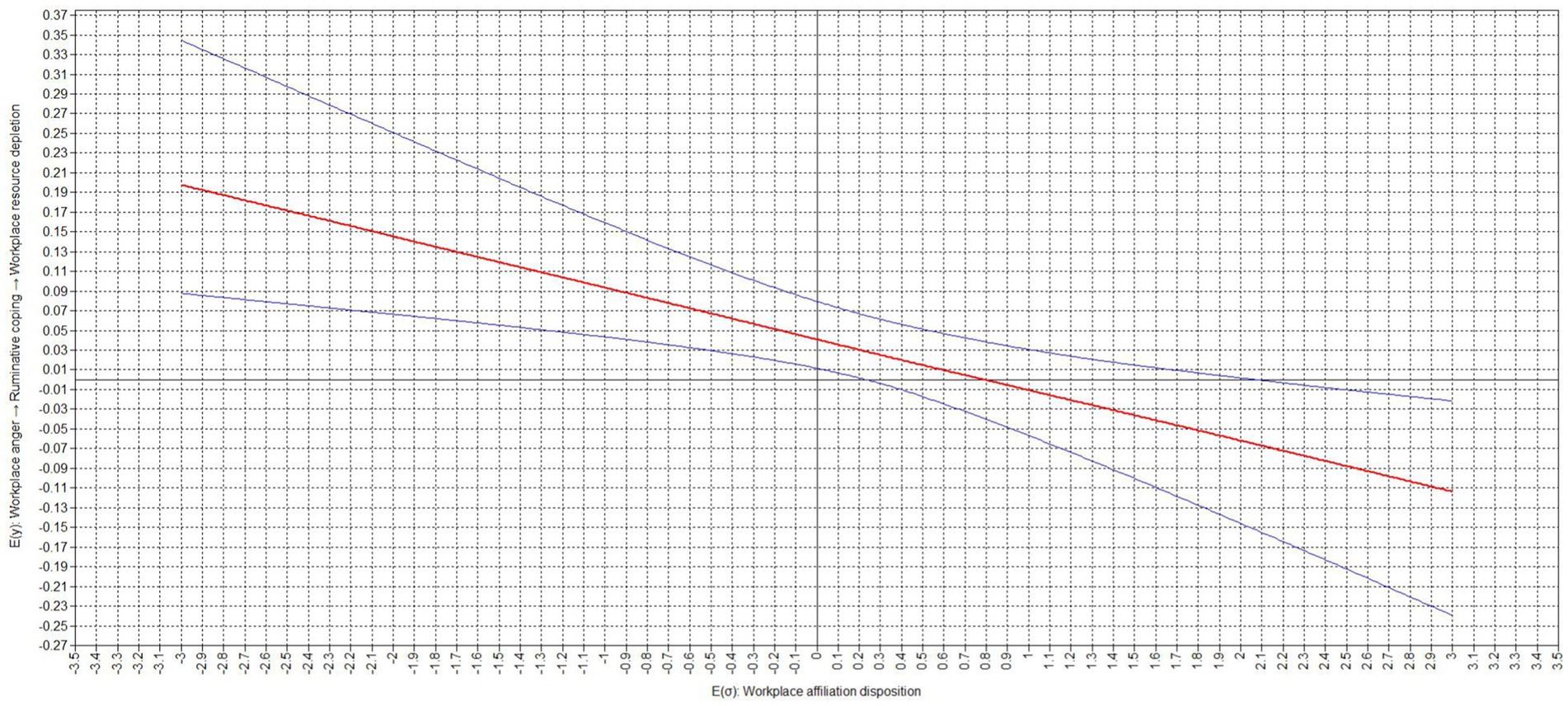
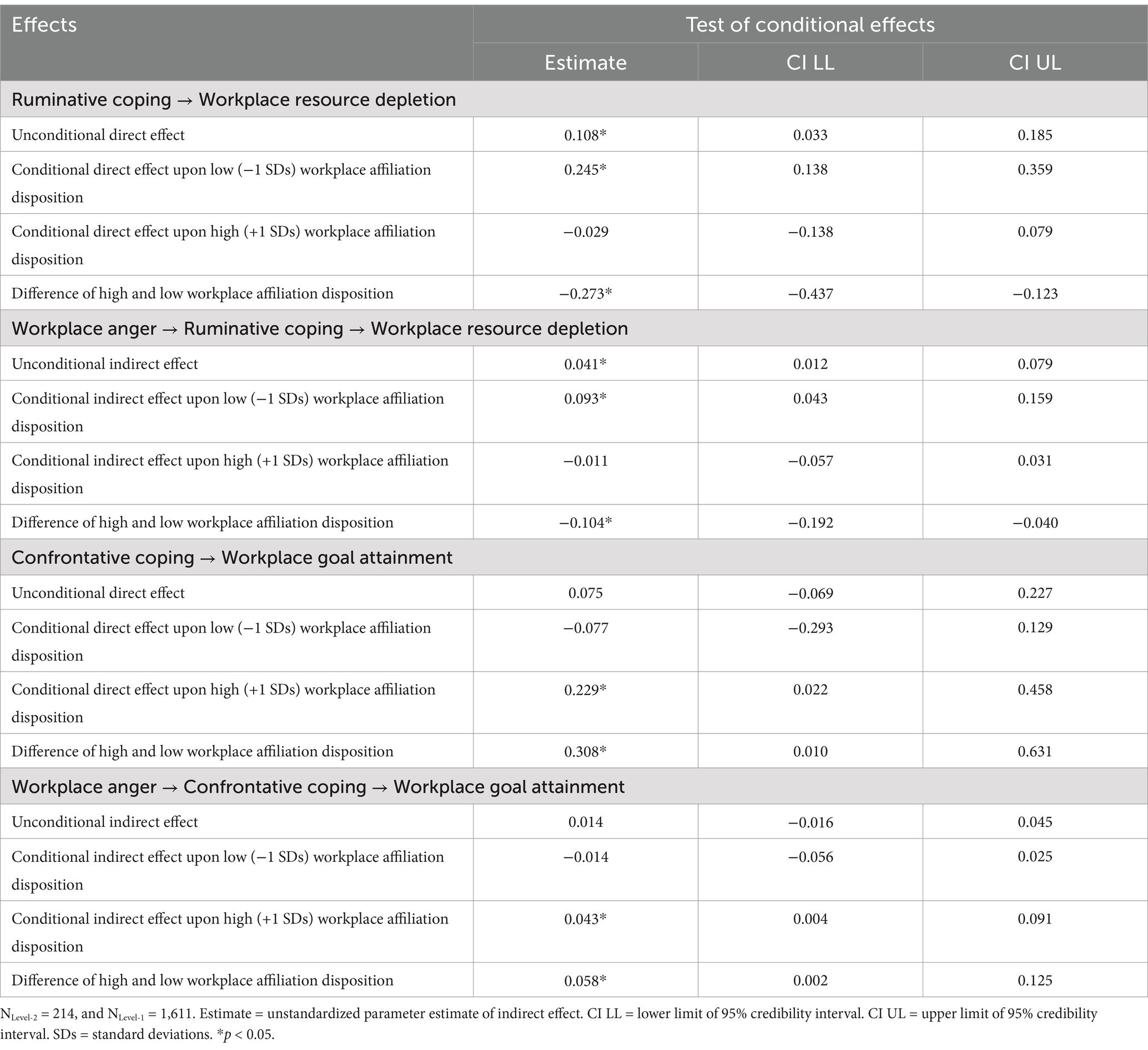
Our outcomes additionally confirmed that the relation between confrontative coping and workplace purpose attainment was moderated by an worker’s workplace affiliation disposition (moderation impact = 0.154, p = 0.042). Our outcomes point out that the relation between confrontative coping and workplace purpose attainment was nonetheless insignificant for low (−1 commonplace deviation; easy slope = −0.077, p = 0.452) however not excessive (+1 commonplace deviation; easy slope = 0.229, p = 0.032) expressions of an worker’s workplace affiliation disposition. The distinction between the slopes was vital (distinction = 0.308, p = 0.042). Equally, the relation between workplace anger and workplace purpose attainment through confrontative coping was additionally nonetheless insignificant for low (−1 commonplace deviation; conditional impact = −0.014, p = 0.452) however not excessive (+1 commonplace deviation; conditional impact = 0.043, p = 0.032) expressions of an worker’s workplace affiliation disposition. The distinction between the slopes was vital (distinction = 0.058, p = 0.042). The corresponding area of significance plots, offered in Figures 4, 5, present that the relation between confrontative coping and workplace purpose attainment in addition to the relation between workplace anger and workplace purpose attainment through confrontative coping didn’t grow to be detrimental and vital, whereas turning into constructive and vital with values of a workplace affiliation disposition of equal to or better than 0.640 commonplace deviations above the pattern imply.
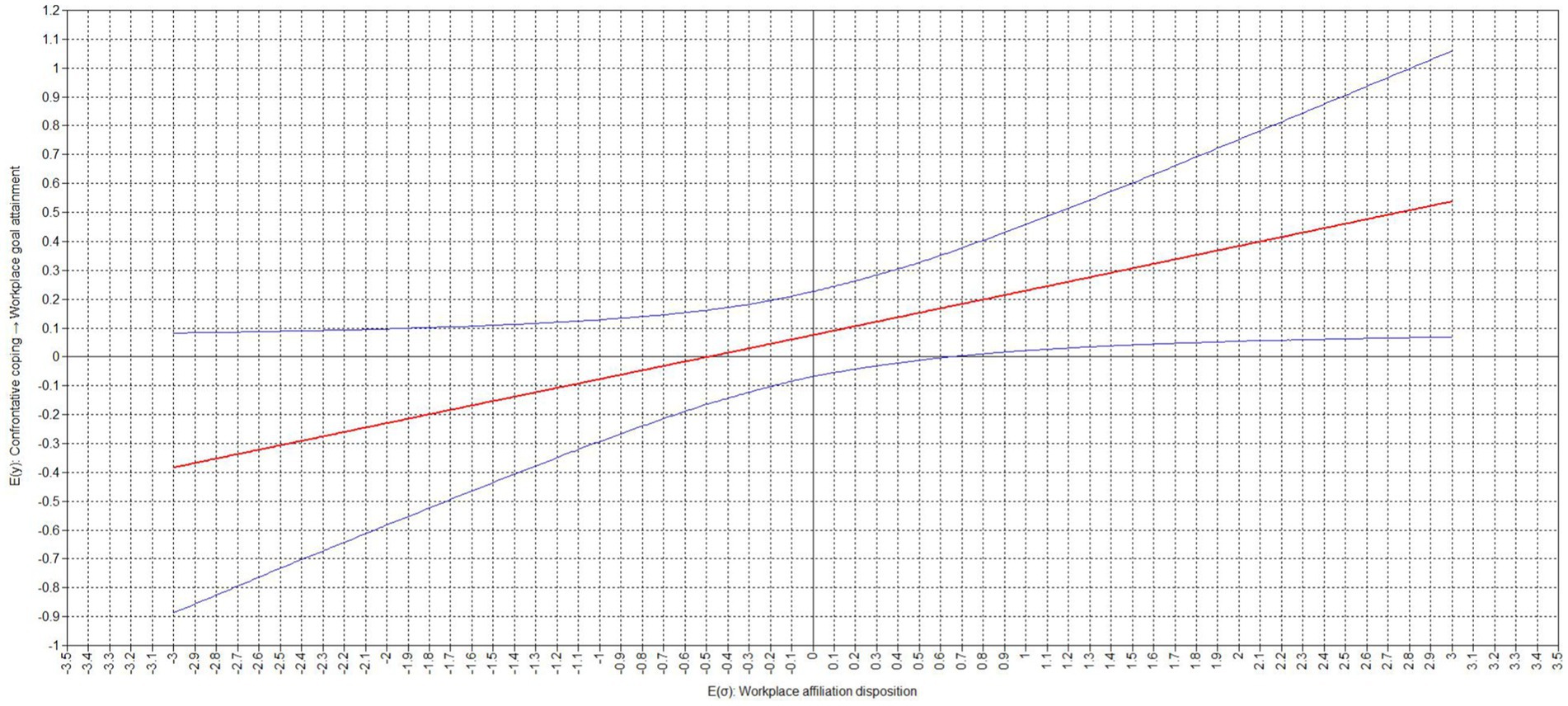

Dialogue
On this manuscript, our major focus was on inspecting the intricate relation between workplace anger, workplace useful resource depletion, and purpose attainment whereas taking into consideration the influence of coping methods and particular person variations. Our primary goal was to problem the frequent perception that workplace anger at all times impedes work outcomes. To attain this purpose, we developed a theoretical mannequin primarily based on affective occasions concept (Weiss and Cropanzano, 1996) and insights from cognitive theories of feelings (Lazarus, 1991; Frijda, 1987; Moors et al., 2013). Our conceptual mannequin means that workplace anger could also be positively associated to workplace useful resource depletion and should have detrimental associations with workplace purpose attainment in sure conditions, however may even have a constructive relation with workplace purpose attainment underneath different circumstances. Elements similar to coping methods for managing anger and particular person variations amongst staff had been considered on this mannequin. With the intention to check our theoretical framework, we gathered knowledge from a gaggle of full-time staff throughout numerous industries utilizing a daily time-lagged experience-sampling methodology over a two-week interval. Opposite to earlier analysis, our outcomes indicated an absence of great affiliation between workplace anger and workplace useful resource depletion, in addition to a constructive connection between workplace anger and purpose attainment, relying on the coping mechanisms employed by staff when confronted with anger-triggering conditions, in addition to their workplace affiliations.
Theoretical implications
Our outcomes have vital theoretical implications. Firstly, our findings counsel that the assumptions of affective occasions concept (Weiss and Cropanzano, 1996) and cognitivist accounts of emotion, which suggest an adversarial relation between workplace anger and useful resource depletion, seem like supported by empirical proof, though solely to a restricted extent. The impact measurement of the relation between workplace anger and useful resource depletion is beneath the edge for a small impact (E(β) = 0.041, r = 0.091; Cohen, 1988; Gignac and Szodorai, 2016), main us to query the sensible validity of those assumptions. Moreover, as this relation was solely vital when mediated by coping methods, you will need to take into account that the interaction between affective responses and work outcomes is contingent upon the intersection of those coping methods. Due to this fact, it could be useful to combine coping methods into affective occasions concept (Weiss and Cropanzano, 1996) to supply a extra complete understanding of the relation between feelings and work outcomes.
The significance of integrating coping methods into affective occasions concept (Weiss and Cropanzano, 1996) is additional clarified when contemplating the assorted intersecting results of coping methods within the relation between workplace anger and work outcomes. Our analysis helps the idea of cognitivist accounts of feelings (Frijda, 1987; Lazarus, 1991; Moors et al., 2013) by demonstrating how numerous coping methods intersect and direct the valence of the relation between workplace anger and work outcomes in numerous methods. Particularly, we discovered that the connection between workplace anger and purpose attainment is considerably adversarial when ruminative coping is taken into account however turns into negligible when confrontative coping is taken into consideration. This identical sample can also be evident within the hyperlink between workplace anger and useful resource depletion. Notably, the oblique results of workplace anger on work outcomes by way of confrontative coping, in addition to the direct results between confrontative coping and work outcomes, are near zero. This implies that the shortage of great outcomes might not be resulting from an absence of statistical energy, however somewhat point out a sensible buffering impact of confrontative coping between workplace anger and work outcomes. This highlights the interaction between coping methods and these constructs, emphasizing the essential position of coping methods within the relation between workplace anger and work outcomes. Due to this fact, incorporating coping methods into affective occasions concept (Weiss and Cropanzano, 1996) may enhance our understanding of how workplace anger pertains to work outcomes.
Nevertheless, we additionally famous that the relations between workplace anger and work outcomes relied on how an worker expressed their disposition towards workplace affiliation. Prior analysis has not completely explored particular person employee-level components inside the context of affective occasions concept, making these findings particularly vital. This disposition seems to play a vital position in shaping the relations between workplace anger, coping methods, and work outcomes. It is very important observe that the relation between workplace anger and useful resource depletion by way of ruminative coping grew to become insignificant when contemplating the interplay between a excessive disposition towards workplace affiliation and these coping methods.
Sensible implications
Concurrently, it’s essential to implement interventions that improve workplace affiliation. Bettering the standard of relations amongst staff by fostering workplace friendships (Methot et al., 2016; van Dick et al., 2004) or creating mutually dependent work groups (Dietz and Fasbender, 2021) ought to assist enhance the need of staff to affiliate with each other, not less than within the quick time period.
Our analysis findings counsel that the constructive relation between anger and purpose attainment depends on the interaction of assertiveness and affiliation components. Thus, solely specializing in one sort of intervention might not be as efficient. As a substitute, implementing each assertiveness and affiliation methods concurrently can result in larger worker purpose attainment charges, in the end bettering organizational efficiency on a daily foundation.
Limitations
In decoding the outcomes of our research, it’s crucial to contemplate its limitations. First, self-report measures might have launched frequent methodology bias (Doty and Glick, 1998), which may compromise the validity of our findings. Due to this fact, it’s advisable for forthcoming analysis efforts to combine other-report research design elements, similar to those who consider worker dyads. This method will help mitigate the potential bias by way of inter-method reliability.
Second, our time-based sampling technique might have impacted our estimates by lacking event-based variance resulting from mounted sampling intervals (Trull and Ebner-Priemer, 2009). We tried to deal with this limitation by setting slender sampling intervals. Nonetheless, future analysis may take into account incorporating random survey prompts to scale back this potential bias additional.
General, you will need to observe that these limitations might considerably prohibit the generalizability and viability of our interpretations and outcomes. Due to this fact, future analysis is inspired to deal with these challenges by way of replication and conceptual growth.
Future analysis instructions
One potential path for future analysis is to experimentally replicate the relations that had been proposed and examined within the present paper. Our method lacks inner validity, indicating that conducting experimental research may assist deal with this limitation. Vignette research might be utilized by future researchers to check our assumptions and convey each inner and exterior validity to the assumed relations (Aguinis and Bradley, 2014).
Future analysis ought to additional discover the shortage of a big impact of confrontative coping on useful resource depletion. It’s value investigating whether or not organizational and management practices that incorporate confrontative approaches towards anger-inducing staff may present a viable framework for sustaining productiveness whereas guaranteeing each short-and long-term worker well-being. Moreover, future research may study whether or not these results—significantly these associated to totally different expressions of workplace affiliation—stay constant throughout numerous workplace cultures and organizational roles.
